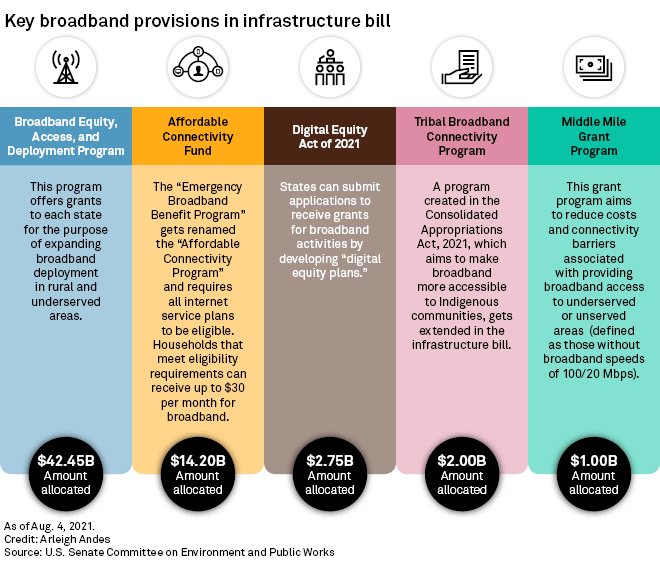S&P Global Offerings
Featured Topics
Featured Products
Events
S&P Global Offerings
Featured Topics
Featured Products
Events
S&P Global Offerings
Featured Topics
Featured Products
Events
Banking & Capital Markets
Economy & Finance
Energy Transition & Sustainability
Technology & Innovation
Podcasts & Newsletters
Banking & Capital Markets
Economy & Finance
Energy Transition & Sustainability
Technology & Innovation
Podcasts & Newsletters
S&P Global Offerings
Featured Topics
Featured Products
Events
9 Feb, 2022
Republicans and Democrats agreed last year to spend tens of billions of dollars on building out internet service, but how and where to spend that money remains hotly debated.
At the Feb. 8 INCOMPAS 2022 policy conference, experts from Capitol Hill and independent U.S. agencies congregated to discuss how to best use the $65 billion allocated to broadband deployment in the bipartisan infrastructure act.
"Congress is going to need to provide assistance, direction and oversight" to make sure the money appropriated is used efficiently to make sure all Americans can afford broadband, said Rep. Mike Doyle, D-Pa.
The National Telecommunications and Information Administration is responsible for handling approximately $48 billion of the $65 billion from the infrastructure legislation, and nearly 90% of that NTIA allotment is to be used for grants in states and U.S. territories to fund high-speed broadband deployment.
Broadband maps
But before the Commerce Department can distribute money to states for broadband projects, it needs the Federal Communications Commission to provide an updated, accurate nationwide broadband map showing which areas of the country remain unserved or underserved.
Commerce Secretary Gina Raimondo told lawmakers earlier this month that the FCC will have updated maps this summer.
Rep. Bob Latta, R-Ohio, plans to make sure the commission sticks to that timeline.
"It's oversight. Oversight, oversight, oversight," Latta said to INCOMPAS CEO Chip Pickering when asked about ensuring the map deadline.
Once the maps are in place, the key for successful broadband deployment will be community engagement, notably with tribal communities, said NTIA's associate administrator in the office of internet connectivity and growth, Doug Kinkoph, who spoke in a summit panel discussing federal distribution of infrastructure dollars. He added that NTIA has been meeting with state broadband leaders twice a month to ensure this.
Engagement with states is critical and key, the U.S. Treasury Department's capital projects funds director, Joseph Wender, later added. "A lot of responsibility has been delegated to the state level — that's what Congress required."
Community engagement
But some advocates believe engagement needs to go beyond the state level to the community level.
Stanley Adams, the Kansas Department of Commerce's director in the office of broadband development, said his office has held multiple webinars with service providers and communities. He encouraged players at the policy summit — both broadband providers and policy workers — to contact local governments to help deliver broadband funding most efficiently.
"We don't bite, reach out to us," said Peggy Schaffer, executive director at ConnectME, a broadband connection advocacy group based in Maine. "We live in a certain realm and we can help you figure out the realm."
The deployments happening today also need to think about the needs of tomorrow, said Ernesto Falcon, policy counsel at the Electronic Frontier Foundation. Projects being financed now must accommodate population and connectivity demands decades from today.
Falcon said agencies should work to extrapolate what future internet capacities would look like. "I think that will help those local communities rationalize those plans" for their futures, he said.
INCOMPAS is a trade association that represents large and small internet, streaming, communications and technology companies. It advocates for laws and policies that promote competition, innovation and economic development.

Segment

